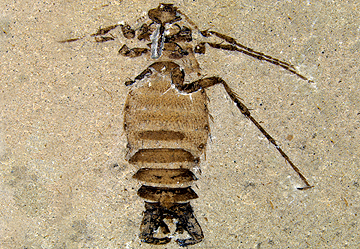Abstract
A new fossil species of Procercopidae, Anthoscytina daidaleos sp. nov., is described and illustrated based on five adult specimens from the Middle to Upper Jurassic Haifanggou Formation at Daohugou, Inner Mongolia, northeastern China. The new species can be distinguished from other species of Anthoscytina Hong, 1983 by the combination of maculated wings and veins RA and RP multi-branched. Our new find sheds further light on the diversity of Jurassic procercopids in the early assemblage of the Yanliao biota from the Daohugou beds.
References
Ansorge, J. (1996) Insekten aus dem Oberen Lias von Grimmen (Vorpommern, Norddeutschland). Neue Palaäontologische Abhandlungen, 2, 1–132.
Becker-Migdisova, E.E. (1949) Mesozoic Homoptera of Middle Asia. Trudy Paleontologicheskogo Instituta, 22, 1–68 [in Russian].
Bourgoin, T., Wang, R., Asche, M., Hoch, H., Soulier-Perkins, A., Stroinski, A., Yap, S. & Szwedo, J. (2015) From micropterism to hyperpterism: recognition strategy and standardized homology-driven terminology of the forewing venation patterns in planthoppers (Hemiptera: Fulgoromorpha). Zoomorphology, 134, 63–77.
https://doi.org/10.1007/s00435-014-0243-6
Burrows, M. (2003) Biomechanics: froghopper insects leap to new heights. Nature, 424, 509.
https://doi.org/10.1038/424509a
Chen, D., Yao, Y. & Ren, D. (2015a) A new species of fossil Procercopidae (Hemiptera, Cicadomorpha) from the Lower Cretaceous of Northeastern China. Cretaceous Research, 52, 402–406.
https://doi.org/10.1016/j.cretres.2014.05.005
Chen, J., Zhang, H.C., Wang, B., Zheng, X.T. & Wang, X.L. (2015b) High variability in tegminal venation of primitive cercopoids (Hemiptera: Cicadomorpha), as implied by the new discovery of fossils from the Middle Jurassic of China. Entomological Science, 18, 147–152.
https://doi.org/10.1111/ens.12103
Chen, J., Wang, B., Zhang, H.C., Wang, X.L. & Zheng, X.T. (2015c) New fossil Procercopidae (Hemiptera: Cicadomorpha) from the Middle Jurassic of Daohugou, Inner Mongolia, China. European Journal Entomology, 112, 373–380.
https://doi.org/10.14411/eje.2015.044
Cryan, J.R. & Svenson, G.J. (2010) Family-level relationships of the spittlebugs and froghoppers (Hemiptera: Cicadomorpha: Cercopoidea). Systematic Entomology, 35, 393–415.
https://doi.org/10.1111/j.1365-3113.2009.00520.x
Evans, J.W. (1946) A natural classification of leaf-hoppers (Homoptera, Jassoidea). Part 1. External morphology and systematic position. Transactions of the Royal Entomological Society of London, 96, 47–60.
https://doi.org/10.1111/j.1365-2311.1946.tb00442.x
Evans, J.W. (1956) Palaeozoic and Mesozoic Hemiptera (Insecta). Australian Journal of Zoology, 4, 164–258.
https://doi.org/10.1071/ZO9560165
Handlirsch, A. (1906–1908) Die fossilen Insekten und die Phylogenie der rezenten Formen: ein Handbuch für Paläontologen und Zoologen. Engelmann, Leipzig, 1430 pp.
Hamilton, K.G.A. (1990) Homoptera. In: Grimaldi D. (ed.). Insects from the Santana Formation, Lower Cretaceous of Brazil. Bulletin of the American Museum of Natural History, 195, 82–122.
Hamilton, K.G.A. (1992) Lower Cretaceous Homoptera from the Koonwarra Fossil Bed in Australia, with a new superfamily and synopsis of Mesozoic Homoptera. Annals of the Entomological Society of America, 85, 423–430.
https://doi.org/10.1093/aesa/85.4.423
Hamilton, K.G.A. (2001) A new family of froghoppers from the American tropics (Hemiptera: Cercopoidea: Epipygidae). Biodiversity, 2, 15–21.
https://doi.org/10.1080/14888386.2001.9712551
Hong, Y.C. (1982) Mesozoic fossil insects of Jiuquan basin in Gansu Province. Geological Publishing House, Beijing, 187 pp. [in Chinese].
Hong, Y.C. (1983) Middle Jurassic fossil insects in North China. Geological Publishing House, Beijing, 223 pp. [in Chinese].
Huang, D.Y. (2015) Yanliao Biota and Yanshan movement. Acta Palaeontologica Sinica, 54, 501–546 [in Chinese, English abstr.].
Huang, D.Y. (2016) The Daohugou Biota. Shanghai scientific and technical publishers, Shanghai, 332 pp. [in Chinese].
Jiang, J.Q. & Huang, D.Y. (2017) New species of Cicadocoris (Hemiptera: Coleorrhyncha: Progonocimicidae) from mid-Jurassic deposits in northeastern China. European Journal Entomology, 114, 355–364.
https://doi.org/10.14411/eje.2017.045
Leach, W.E. (1815) Entomology. In: Brewster D. (ed.): The Edinburgh Encyclopaedia, Vol. 9, Part 1. William Blackburn, Edinburgh, 384 pp.
Li, S., Shih, C., Wang, C., Pang, H. & Ren, D. (2013) Forever love: The hitherto earliest record of copulating insects from the Middle Jurassic of China. PLoS ONE 8, e78188.
https://doi.org/10.1371/journal.pone.0078188
Liao, H.Y., Shen, Y.B. & Huang, D.Y, (2017) Conchostracans of the Middle- Late Jurassic Daohugou and Linglongta beds in NE China. Palaeoworld, 26, 317–330.
https://doi.org/10.1016/j.palwor.2016.11.001
Linnaeus, C. (1758) Systema naturae per regna tria naturae, secundum classes, ordinus, genera, species, cum characteribus, differentiis, synonymis, locis. 10th ed, Vol. 1. Holmiae Salvii, 824 pp.
Martynov, A.V. (1937) Liassic insects from Shurab and Kisyl-Kiya Part I Various orders except Blattodea and Coleoptera. Trudy Paleontologicheskogo Instituta, 7, 1–178. [in Russian].
Nel, A., Prokop, J., Nel, P., Grandcolas, P., Huang, D.Y, Roques, P., Guilbert, E., Dostál, O. & Szwedo, J. (2012) Traits and evolution of wing venation pattern in paraneopteran insects. Journal of morphology, 273, 480–506.
https://doi.org/10.1002/jmor.11036
Paladini, A., Takiya, D.M., Urban, J.M. & Cryan, J.M. (2018) New World spittlebugs (Hemiptera: Cercopidae: Ischnorhininae): Dated molecular phylogeny, classification, and evolution of aposematic coloration. Molecular phylogenetics and evolution, 120, 321–334.
https://doi.org/10.1016/j.ympev.2017.12.020
Rakitov, R.A. (2002) Structure and function of the Malpighian tubules, and related behaviors in juvenile cicadas: Evidence of homology with spittlebugs (Hemiptera: Cicadoidea & Cercopoidea). Zoologischer Anzeiger, 241, 117–130.
https://doi.org/10.1078/0044-5231-00025
Ren, D. (1995) Systematic Palaeontology. Fossil insects. In Ren, D., Lu, L., Guo, Z. & Ji, S. (eds): Fauna and Stratigraphy of Jurassic-Cretaceous in Beijing and the Adjacent Areas. Seismic Publishing House, Beijing, pp. 47–120 [in Chinese, English abstr.].
Shcherbakov, D.E. (1988) New cicadas (Cicadina) from the Late Mesozoic of Transbaikalia. Paleontological Journal, 4, 55–66.
Shcherbakov, D.E. & Popov, Y.A. (2002) Superorder Cimicidea Laicharting, 1781 order Hemiptera Linné, 1758. The bugs, cicadas, plantlice, scale insects, etc. In: Rasnitsyn A.P. & Quicke D.L.J. (eds): History of insects. Kluwer, Dordrecht, pp. 152–155.
Wang, B. & Zhang, H.C. (2009) A remarkable new genus of Procercopidae (Hemiptera: Cercopoidea) from the Middle Jurassic of China. Comptes Rendus Palevol, 8, 389–394.
https://doi.org/10.1016/j.crpv.2009.01.003
Wang, B., Szwedo, J. & Zhang, H.C. (2012) New Jurassic Cercopoidea from China and their evolutionary significance (Insecta: Hemiptera). Palaeontology, 55, 1223–1243.
https://doi.org/10.1111/j.1475-4983.2012.01185.x

